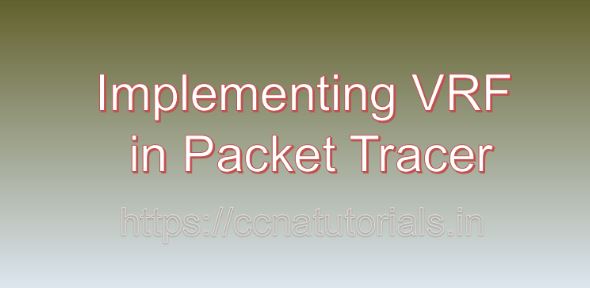Contents of this article
In this article, I describe the process of Implementing VRF in Packet Tracer. In modern networking, Virtual Routing and Forwarding (VRF) emerges as a powerful tool for network segmentation and isolation. VRF allows multiple routing tables to coexist within a single router, enabling distinct routing instances for different network segments or tenants. This article delves into the implementation of VRF in Packet Tracer, a widely used network simulation tool. We’ll provide a comprehensive guide with step-by-step instructions and practical examples to help network enthusiasts and professionals understand and master VRF implementation.
Understanding Virtual Routing and Forwarding (VRF):
Before diving into configuration, let’s comprehend the concept of VRF:
- Overview:
VRF is a technology that enables multiple routing instances to operate on the same physical router, providing network segmentation and isolation. - Routing Tables:
Each VRF has its own routing table, forwarding decisions, and routing protocols, allowing for independent routing decisions. - Use Cases:
VRF is commonly used in scenarios requiring network isolation, such as service provider networks, virtual private networks (VPNs), and multi-tenant environments.
Setting up the Environment:
Begin by creating a network topology in Packet Tracer for VRF implementation:
- Topology Design:
Design a simple network topology consisting of routers, switches, and hosts. - Router Configuration:
Assign IP addresses to router interfaces and enable routing protocols as needed.
Configuring VRF on Packet Tracer:
Let’s explore how to implement VRF in Packet Tracer using Cisco IOS commands:
- Access Router CLI: Right-click on a router and select “Command Line Interface.”
- Enter Global Configuration Mode: Type “enable” and then “configure terminal.”
- Define VRF Instances: Use the “vrf definition” command to create VRF instances with unique names.
- Assign Interfaces to VRF: Specify which interfaces belong to each VRF using the “interface” command followed by the “vrf forwarding” command.
- Configure IP Addresses: Assign IP addresses to VRF interfaces within their respective address spaces.
- Enable Routing Protocols: Configure routing protocols (e.g., OSPF, EIGRP) within each VRF instance to establish routing connectivity.
Example: Implementing VRF for Network Segmentation:
Let’s walk through an example of implementing VRF in Packet Tracer for network segmentation:
- Topology Setup: Create a topology with a router connecting two separate LAN segments.
- VRF Configuration:
- Define VRF Instances: Create two VRF instances named “VRF1” and “VRF2” using the “vrf definition” command.
- Assign Interfaces: Associate LAN interfaces with their respective VRFs using the “interface” and “vrf forwarding” commands.
- Configure IP Addresses: Assign IP addresses to VRF interfaces within their address spaces.
- Enable Routing Protocols: Configure OSPF within each VRF instance to enable routing between VRFs.
Testing and Verification:
After configuring VRF, it’s essential to test and verify the setup:
- Packet Tracer Simulation:
Simulate traffic flows between hosts in different VRFs to ensure proper isolation and routing. - Verification Commands:
Execute commands like “show ip route vrf ” and “show ip ospf neighbor vrf ” to verify VRF configurations and routing table entries.
Real-World Applications:
Explore real-world scenarios where VRF is commonly employed:
- Service Provider Networks:
Use VRF to segregate customer traffic in a shared network infrastructure, ensuring privacy and isolation. - VPN Services:
Implement VRF to create separate VPN instances for different customers or departments within an organization. - Multi-Tenant Environments:
Utilize VRF to provide network segmentation for multiple tenants sharing the same physical infrastructure, such as in co-location facilities.
Conclusion for Implementing VRF in Packet Tracer:
Implementing VRF in Packet Tracer offers a valuable learning experience for network enthusiasts and professionals. By following the steps outlined in this guide and experimenting with practical examples, individuals can gain a deeper understanding of VRF concepts and their practical implementation.
So, dive into Packet Tracer, explore VRF configurations, and unlock the power of network segmentation and isolation with Virtual Routing and Forwarding. I hope you found this article helpful related to Implementing VRF in Packet Tracer. You may contact us or drop a comment below for any query or suggestions about the contents of this website.






